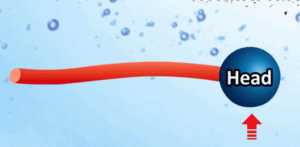How Does Laundry Detergent Work?
-
 By
Sophia Grant
By
Sophia Grant
Nowadays, there are many types of detergent that we can use to wash our clothes. Some are powders while others are a liquid.
Of course, there are other laundry detergent formulas to choose from as well including pods, which take the measuring out of doing the laundry.
How does laundry detergent work? Should you use them with warm or hot water? Are they compatible with all washing machines?
For the answers, be sure to keep reading. We’ll be going over how laundry detergent works in detail below.
Different Types of Laundry Detergent
 Different types of laundry detergent are designed to do the same thing (i.e. clean clothes), however, they’re slightly different in how they’re made and used.
Different types of laundry detergent are designed to do the same thing (i.e. clean clothes), however, they’re slightly different in how they’re made and used.
Let’s take a closer look at them below.
Powder Laundry Detergent
Powdered laundry detergents were the first type of detergent that was introduced to the market.
They contain the same laundry detergent ingredients as other products and are able to get your clothes clean effectively.
Pros of Powder Detergents

Powdered liquid detergents are generally cheaper than other types of detergents (e.g. liquids, pods).
Not only that but they often come in cardboard boxes, which makes them better for the environment.
That’s not all—powder detergents also have a longer shelf life. Generally speaking, they can last upwards of a year if left unopened. Still, you should always try to use it up as soon as possible once you’ve opened the packaging.
In some cases, they can also outperform liquids. For example, powders tend to have greater bleaching abilities.
Cons of Powders
First and foremost, you want to be careful not to get the box of detergent wet – otherwise, the product might be ruined.
Pretreating also takes more effort with powders. Instead of being able to just pour it onto the fabric, you have to first mix the powder with water separately in a bowl to make a paste. Still, it’s just as effective.
Liquid Laundry Detergents

Liquid laundry detergents were first introduced in the 1950s. Since then, they’ve become one of the most popular formulations.
Pros of Liquid Detergents
Liquid detergents have several advantages. For starters, it does not require pre-mixing – you can just use it out of the bottle.
Convenient and easy to use, they are perfect for pretreating stains. Given that you use the proper amount, they’re also less likely to clog up your washing machine.
They don’t get airborne like powdered detergent either.
Cons of Liquid Laundry Detergents
Liquids typically come in plastic bottles, which are not very environmentally friendly; it can take hundreds of years for the polymers to break down in the landfill.
Price-wise, they’re also more expensive than their powdered counterpart. Not to mention that they generally have a shorter shelf life.
Given that they don’t contain bleach, they’re also not as effective for stain removal.
Detergent Pods
Pods are the newest detergent type—they’re convenient and easy to use, more so than liquid detergents! However, that doesn’t always make them the best choice.
Pros of Detergent Pods
Pods are popular because they are convenient. Single-dose, they don’t require any measuring or guesswork.
Small and compact, they require very little storage space. They also remain stable for longer, which means they have a longer shelf life.
Cons of Laundry Pods
Pods are without a doubt, the most expensive type of laundry detergent out there.
Designed for average load sizes, one pod will likely not be enough to wash a large load of clothes. In cases like that, you may have to use two pods, which will greatly increase costs.
Given that they’re “pre-dosed”, you also can’t adjust the amount for pre-treating or hand washing. If anything, they are only suitable if you’re washing your clothes with the machine.
 The Main Ingredients of Laundry Detergents Explained
The Main Ingredients of Laundry Detergents Explained
All laundry detergents contain anionic surfactants. These substances are responsible for lowering the surface tension between two liquids.
What is surface tension? It’s a force that allows water to hold its shape and not “spread out.” These forces are broken down by the surfactant molecules, which allow the grease to be washed away. In other words, it improves the water’s ability to wet things, aka your clothes.
Physically, they have a head that is attracted to water and a tail that’s attracted to grease and dirt. When detergent molecules meet the grease, it draws in the oils while the heads remain in the water. Eventually, the attractive forces between the head and the water will lift the grease from the surface. This grease is then broken into smaller components by the detergent and washed away by water.
Surfactants aren’t the only thing that’s in laundry detergents. For instance, you’ll often find optical brighteners, chemicals that will brighten your clothes, and enzymes that will dissolve and break down the gunk.
 Washing Clothes with Laundry Detergents
Washing Clothes with Laundry Detergents
Now that we know what they’re made out of, let’s go over how they work from the top.
1. You throw your dirty leggings into the washing machine. During the wash cycle, the anionic surfactants from the laundry detergent will mix and dissolve in the water.
2. The surfactant’s grease-loving tails will attach themselves to the grease that’s on your leggings. The mechanical energy from the throwing and tumbling motions will help break the dirt into smaller pieces, making them easier to remove.
3. Water molecules attach themselves to the heads of the surfactant molecules during the rinse cycle.
4. The water molecules will eventually pull the surfactant and grease away from the leggings. The final rinse will help to drain away the dirty water.
How Does Laundry Detergent Work – FAQs
Should I use cold water or hot water to wash clothes?
Cold water is generally gentler on your clothes. Hot water, on the other hand, is better at removing oily dirt and germs.
Which laundry detergent is good for sensitive skin?
Those with sensitive skin should use a soap and detergent that’s free of harmful chemicals. Artificial fragrances should also be avoided as they can acuse skin irritation.
What is caustic soda for?
Caustic soda can be used to clean your washing machine. However, it’s not the best choice as it’s very corrosive and can damage the parts over time.
Using a commercial product like ACTIVE Washing Machine Cleaner is a much better option.
Now you know how laundry detergent works! As you can see, it all boils down to the ingredients and their chemical reactions.
15% Off Amazon Coupon
×Click To Reveal The 15% Off Coupon Code For Your Entire ACTIVE Purchase At Amazon.com
Note: This promotional offer is only guaranteed through the end of the day.




